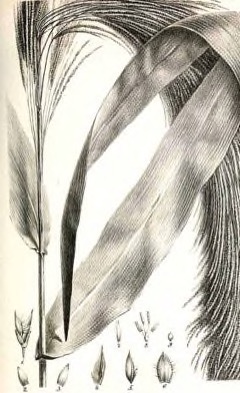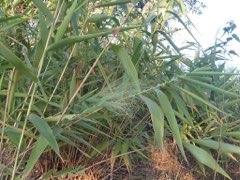 |
|
http://www.edibleplants.org |
 |
| MKar wikimedia.org |
Translate this page:
Summary
Thysanolaena latifolia, or commonly known as Tiger Grass or Asian Broom Grass is the sole species in the Thysanolaeneae genus. Its stem is round and solid. The leaves are narrow, large, leathery, heart-shaped, and taper to a fine point. Flowers are brownish. Fruits are small grains. The fresh leaf buds are eaten. No plant part of this species is of medicinal importance. However, T. latifolia is utilized mainly as hedges and to provide screening. Its flowering panicles are used to make light dust brooms which are highly durable. Plants are grown from seeds.
Physical Characteristics

 Thysanolaena latifolia is an evergreen Perennial growing to 3 m (9ft) by 3 m (9ft) at a fast rate.
Thysanolaena latifolia is an evergreen Perennial growing to 3 m (9ft) by 3 m (9ft) at a fast rate.
See above for USDA hardiness. It is hardy to UK zone 10.
Suitable for: light (sandy), medium (loamy) and heavy (clay) soils and prefers well-drained soil. Suitable pH: mildly acid, neutral and basic (mildly alkaline) soils. It cannot grow in the shade. It prefers moist soil.
UK Hardiness Map
US Hardiness Map
Synonyms
Agrostis latifolia Heyne ex Bor Agrostis maxima Roxb. Agrostis scoparia J.K?nig ex Bor Melica latifo
Plant Habitats
Edible Uses
References More on Edible Uses
Medicinal Uses
Plants For A Future can not take any responsibility for any adverse effects from the use of plants. Always seek advice from a professional before using a plant medicinally.
None known
References More on Medicinal Uses
The Bookshop: Edible Plant Books
Our Latest books on Perennial Plants For Food Forests and Permaculture Gardens in paperback or digital formats.

Edible Tropical Plants
Food Forest Plants for Hotter Conditions: 250+ Plants For Tropical Food Forests & Permaculture Gardens.
More

Edible Temperate Plants
Plants for Your Food Forest: 500 Plants for Temperate Food Forests & Permaculture Gardens.
More

More Books
PFAF have eight books available in paperback and digital formats. Browse the shop for more information.
Shop Now
Other Uses
Broom Hedge
Agroforestry Uses: The plant is frequently grown to provide screening and hedges[200 , 317 ]. Other Uses The flowering panicles are used to make light, dust brooms[46 ]. The panicles are harvested after flowering[317 ]. In the Philippines a very characteristic, light dust broom is made of the panicles of this grass[345 ]. These brooms are extensively used for sweeping the highly polished hardwood floors so characteristic of the better houses in the Philippines. The panicles of this species are considered to make the best grade of these brooms, and for this purpose they are gathered extensively in some parts of the Islands. The handles of the brooms are made of the flowering stems variously interwoven or bound together, the panicles being arranged in a fan-like fashion to form the broom itself. The brooms are decidedly pretty and very effective for their special purpose[345 ]. Thysanolaena brooms are more durable than those made from Phragmites and command a higher price[345 ].
Special Uses
Hedge
References More on Other Uses
Cultivation details
Requires a rich soil and a position in full sun[200 ]. Bloom Color: Rose/Mauve. Spacing: 12-15 in. (30-38 cm).
References Carbon Farming Information and Carbon Sequestration Information
Temperature Converter
Type a value in the Celsius field to convert the value to Fahrenheit:
Fahrenheit:
The PFAF Bookshop
Plants For A Future have a number of books available in paperback and digital form. Book titles include Edible Plants, Edible Perennials, Edible Trees,Edible Shrubs, Woodland Gardening, and Temperate Food Forest Plants. Our new book is Food Forest Plants For Hotter Conditions (Tropical and Sub-Tropical).
Shop Now
Plant Propagation
Seed -
Other Names
If available other names are mentioned here
Amreso, Chyas, Buloh teberau, Rumput buloh, Menjalin wuwu, Awis, Kaso beurit, Tamiyang balu, Pirlu, Tangtang angin, Bouquet-grass, Kuchi, Phuljanta, Phulbadhuni, Hmunphiah, Ophi, Bushnia, Karsar, Garajono, Barucha, Chir, amreso, amrisau, chyas, gerai, huk, karauti chhe, mra, mro kucha, mí, phurke, phys, sarsi, sellosang, tiger grass, tuphi.
Native Range
TEMPERATE ASIA: China (south), Japan, Taiwan TROPICAL ASIA: India, Sri Lanka, Nepal, Pakistan (north), Myanmar, Thailand, Malaysia (Malaya)
Weed Potential
Right plant wrong place. We are currently updating this section.
Please note that a plant may be invasive in one area but may not in your area so it's worth checking.
Conservation Status
IUCN Red List of Threatened Plants Status : This taxon has not yet been assessed

Growth: S = slow M = medium F = fast. Soil: L = light (sandy) M = medium H = heavy (clay). pH: A = acid N = neutral B = basic (alkaline). Shade: F = full shade S = semi-shade N = no shade. Moisture: D = dry M = Moist We = wet Wa = water.
Now available:
Food Forest Plants for Mediterranean Conditions
350+ Perennial Plants For Mediterranean and Drier Food Forests and Permaculture Gardens.
[Paperback and eBook]
This is the third in Plants For A Future's series of plant guides for food forests tailored to
specific climate zones. Following volumes on temperate and tropical ecosystems, this book focuses
on species suited to Mediterranean conditions—regions with hot, dry summers and cool, wet winters,
often facing the added challenge of climate change.
Read More
Expert comment
Author
(Roxb. ex Hornem.) Honda
Botanical References
Links / References
For a list of references used on this page please go here
A special thanks to Ken Fern for some of the information used on this page.
Readers comment
| Add a comment |
|
If you have important information about this plant that may help other users please add a comment or link below. Only comments or links that are felt to be directly relevant to a plant will be included. If you think a comment/link or information contained on this page is inaccurate or misleading we would welcome your feedback at [email protected]. If you have questions about a plant please use the Forum on this website as we do not have the resources to answer questions ourselves.
* Please note: the comments by website users are not necessarily those held by PFAF and may give misleading or inaccurate information.
To leave a comment please Register or login here All comments need to be approved so will not appear immediately.
|
Subject : Thysanolaena latifolia
|
|
|
|